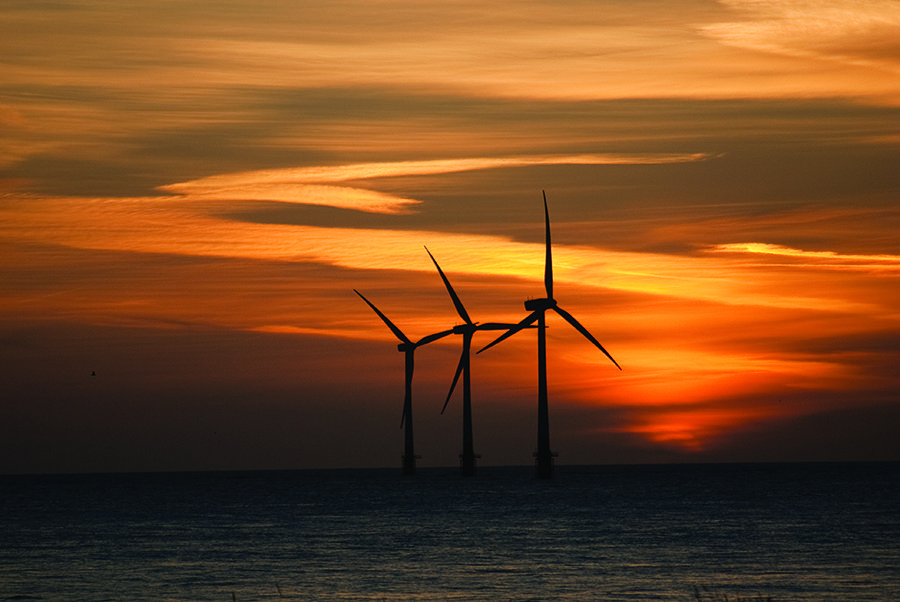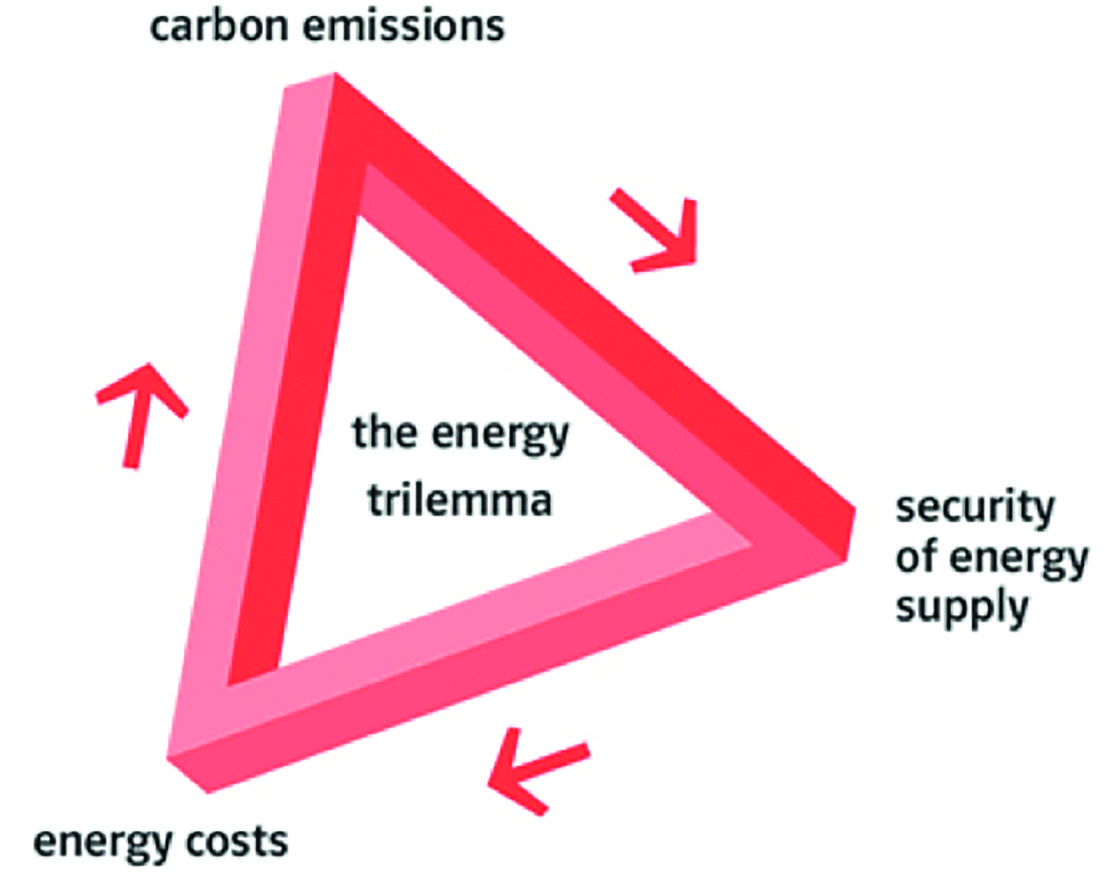 The offshore wind sector remains committed to delivering a safe and sustainable energy future. Nick Medic and Chris Streatfeild highlight the challenges and opportunities for the industry in 2015.
The offshore wind sector remains committed to delivering a safe and sustainable energy future. Nick Medic and Chris Streatfeild highlight the challenges and opportunities for the industry in 2015.
The start of 2015 offers a timely opportunity to look ahead at the challenges and opportunities facing the UK offshore wind sector, not to mention the safety priorities that are likely to be at the forefront of discussions.

Figure 1
It is clear that UK energy policy is taking centre stage in the run up to the forthcoming General Election, with considerable political and economic debate around the so-called Energy Trilemma (see figure 1).[1]
Building a low-carbon economy based on renewable energy is vital if we are to reduce carbon emissions, improve the security of the UK energy supply and ensure that energy costs are effectively controlled.
The offshore wind sector is an essential part of the UK energy mix and it will have an increasingly important role to play over future years.
The UK is rightly seen as the global leader in offshore wind. Currently, with over 4GW of installed offshore wind capacity, and another 1GW in construction, offshore wind supplies close to five per cent of the UK’s electricity. This is set to rise to around ten per cent by 2020.
These figures are impressive, but the overriding message is that this delivery must be achieved without compromising the health, safety or wellbeing of the workforce. So what are the most significant health and safety issues for offshore wind for 2015?
Looking ahead, the health and safety areas that we expect to see substantial progress in, and which will attract debate include:
- An industry response to the new regulatory landscape arising out of the Löfstedt changes and the revised HSE-led interventions, including its more commercial re-positioning.
- Higher levels of stakeholder engagement with industry partners by leveraging the best risk reduction outcomes for the industry.
- A proactive industry response to manage the step change in scale and complexity of the next generation of turbines and complexity of projects often located far away from the coastline.
A new safety paradigm?
Forty years since the Heath and Safety at Work etc. Act 1974 came into force some in the industry are asking whether we are starting to see the emergence of a new safety paradigm. The answer is probably not, but change is certainly happening. The numerous consultations we have seen over the last two years, as a direct result of the Löfstedt review[2], are unlikely to have any dramatic impact on the industry.
Most of the changes are a natural evolution of a move to ‘better regulation’ and recognition of the need to ‘tidy up’ relevant regulations and guidance.
However, some changes perhaps signify a structural change of direction in the regulatory and enforcement landscape in the UK.
Two specific examples are:
- Proposals to exempt self-employed persons from section 3(2) of the Health and Safety at Work etc. Act 1974.[3]
- HSE2020 strategy: a statement of the HSE board’s strategic vision for HSE as an organisation in August 2014, which stated a commitment to, “Recover more of the costs of regulation from those who create risks and drive down HSE’s costs to the taxpayer and paying industry.”[4]
HSE is seen as a global exemplar in health and safety enforcement. However, there is concern that its status and effectiveness is potentially being compromised on the back of the current deregulatory programmes, especially when coupled with its proposed new commercial orientation.
Despite some protections, many industry groups and safety professionals are at best cautious that this redirection could be poorly judged and in fact could prove counterproductive.
The offshore wind sector, as with all responsible industries, fully accepts the Robens principle that, “Those that create risk are best placed to manage it”. The industry hopes that 2015 will provide some tangible assurances that its concerns in this area prove to be unfounded.
Partnership & stakeholder engagement
The offshore wind industry’s growth in recent years has resulted in a number of new and not so new organisations taking an interest in the sector.
During the early years of development there were some competing and conflicting views about how best to manage risks. This was perhaps understandable when looking at the different cultures, regulatory regimes and technical standards that were being presented as the ‘correct’ solution.
A significant and positive change in recent years, which we expect to see continue in 2015, has been a recognition of the importance in adopting a true design-led approach aimed at reducing risks across the entire life-cycle of the offshore wind sector – not just, for example, looking at the construction phase.[5]
In most cases, the best outcome is nearly always drawing on the available standards and guidance that have worked well in other sectors (e.g. construction, marine, oil and gas, marine contracting) and then adapting this to the specific risk profile of the wind sector.
It is based on this common sense and pragmatic approach that some of the sector’s major stakeholders have worked more closely together to achieve a common, shared goal of reducing risks wherever they arise.
RenewableUK, along with groups such as the International Marine Contractors Association, the G9, the Global Wind Organisation and the Crown Estate[6] , as well as regulators (e.g. HSE, Maritime & Coastguard Agency, Civil Aviation Authority) have made substantial progress by working together to produce new industry guidance and standards.
While the publication of up-to-date health and safety good practice is an important and tangible output, the most important benefit will be a more open and shared vision that drives down the risks in future years.
Bigger turbines: bigger projects
Since the early 2000s, the UK offshore wind sector has grown through a series of development ‘rounds’.
The industry is already making substantial progress in the development of round 3 projects, part of the latest and most ambitious offshore development programmes to date. This follows the completion of round 1 and the near completion of the earlier round 2 projects.
While each project is unique, due to its location characteristics (e.g. geothech/geophys/metocean) and particular ownership, contractual, and operation and maintenance model, a common factor that dominates safety risk profiles is the sheer size and scale of the turbines and project configurations. Bigger turbines, expected to be of a capacity of at least 5MW and over 150 metres (450 foot) high, located up to 100nm offshore, illustrate the construction and operational challenges that will need to be managed.
A good example that sets out the step change in the risk management of the offshore wind sector now being driven forward is the industry’s response to managing major incidents.
OREEF [7], a joint-industry working group, is developing a common industry-wide integrated emergency response plan (IERP), based on the oil and gas template.[8] The IERP would set out a common framework to plan, implement and test the effectiveness of emergency arrangements for each project.
It would aim to:
- provide clarity in the command and control for managing major incidents;
- set out arrangements for when and how any escalation of response is put into effect;
- enable flexibility in the plan to take into account project-specific characteristics;
- clarify the practical arrangements needed to support the implementation of the plan;
- reinforce the importance of regular exercises to test the actual effectiveness of the plans; and
- emphasise the importance of competence and training of all persons with any role in the effective implementation and operation of the plan.
It is clear that 2015 will be a busy and challenging year for the offshore wind sector. While there remain some political and economic uncertainties in the months ahead, one common thread will be the priority given to the health, safety and wellbeing of all employees.
The leading stakeholders in the offshore wind sector are committed to delivering the safe and sustainable energy future this country needs.
Nick Medic is director of Offshore Renewables, RenewableUK and Chris Streatfeild is director of health and safety, RenewableUK and a member of SHP’s editorial board.
References:
- Sources numerous. Specific acknowledgement to Eon regarding the diagram used https://www.eonenergy.com/for-your-business/large-energy-users/manage-energy/energy-efficiency/decentralised-energy-experts/The-energy-trilemma
- https://www.gov.uk/government/uploads/system/uploads/attachment_data/file/66790/lofstedt-report.pdf
- Consultation on proposals to exempt self-employed persons from section 3(2) of the Health and Safety at Work etc. Act 1974. http://www.hse.gov.uk/consult/condocs/cd273.htm
- http://www.hse.gov.uk/aboutus/meetings/hseboard/2014/130814/paugb1468.pdf
- The RenewableUK Offshore Wind and Marine Energy H&S Guidelines provide a good overview of the lifecycle risks and control regimes across the lifecycle of an offshore wind project. http://www.renewableuk.com/en/publications/index.cfm/2013-03-13-hs-guidelines-offshore-wind-marine-energy
- IMCA: See http://www.imca-int.com/; G9 See http://www.g9offshorewind.com/; GWO: See http://www.windpower.org/en/global_wind_organisation/about_gwo.html; the Crown Estate: See http://www.thecrownestate.co.uk/energy-and-infrastructure/offshore-wind-energy/
- The Offshore Renewable Energy Emergency Forum (OREEF) has been established to coordinate emergency preparedness in support of activity arising from the development, construction and operation of renewable energy installations. Participants in OREEF include representation from government organisations, regulators (HSE, MCA), agencies, emergency services, industry and service providers. See http://www.renewableuk.com/en/our-work/health-and-safety/the-offshore-renewable-energy-forum-oreef.cfm
- http://www.epolgroup.co.uk/publications/guidance-documents/offshore-emergency-response/
The Safety Conversation Podcast: Listen now!
The Safety Conversation with SHP (previously the Safety and Health Podcast) aims to bring you the latest news, insights and legislation updates in the form of interviews, discussions and panel debates from leading figures within the profession.
Find us on Apple Podcasts, Spotify and Google Podcasts, subscribe and join the conversation today!



